Downwards movement continues as all three Elliott wave counts expected.
Summary: The long-term target is now calculated at 473. Confidence in this target may be had with a new low below 1,160.75.
For the short term, expect downwards movement to continue. It may exhibit increased momentum and strength.
When a five down is complete, then a bounce for a second wave may find resistance at the lower edge of the blue channel.
New updates to this analysis are in bold.
Grand SuperCycle analysis is here.
Last historic analysis with monthly charts is here.
MAIN ELLIOTT WAVE COUNT
WEEKLY CHART – TRIANGLE
This is the preferred wave count.
Cycle wave b may be a complete regular contracting triangle. If it continues further, then primary wave E may not move beyond the end of primary wave C above 1,365.68.
Four of the five sub-waves of a triangle must be zigzags, with only one sub-wave allowed to be a multiple zigzag. Wave C is the most common sub-wave to subdivide as a multiple, and this is how primary wave C for this example fits best.
There are no problems in terms of subdivisions or rare structures for this wave count. It has an excellent fit and so far a typical look.
This wave count would expect a cycle degree trend change has just occurred. Cycle wave c would most likely make new lows below the end of cycle wave a at 1,046.27 to avoid a truncation.
Primary wave E should exhibit reasonable weakness as it comes to an end. Triangles often end with declining ATR, weak momentum and weak volume.
If this weekly wave count is correct, then cycle wave c downwards should develop strength, ATR should show some increase, and MACD should exhibit an increase in downwards momentum.
A target is calculated for cycle wave c that expects to exhibit the most common Fibonacci ratio to cycle wave a.
DAILY CHART – TRIANGLE
Further confidence in this wave count may be had with a breach of the blue channel by a full daily candlestick below and not touching the lower edge. This may occur tomorrow.
Classic analysis offers good support to this wave count, so some confidence may be had in it.
Cycle wave c must subdivide as a five wave structure, either an impulse or an ending diagonal. An impulse is much more common and that shall be how it is labelled unless overlapping suggests a diagonal should be considered.
A new trend at cycle degree should begin with a five wave structure on the daily chart, which will be labelled minor wave 1. When minor wave 1 is complete, then minor wave 2 may not move beyond its start above 1,345.90.
After the blue channel is breached, then a bounce may test resistance at the lower edge.
HOURLY CHART
Minute waves i,ii and iii may be complete.
Minute wave iv may not move into minute wave i price territory above 1,321.95.
An Elliott channel is drawn about minor wave 1 using Elliott’s first technique. Although this channel does not contain all movement, it may still show where minute wave iv finds resistance. Minute wave iv may also find resistance about the lower edge of the wider blue channel, which is copied over from the daily chart.
When minor wave 1 may be complete, then minor wave 2 may unfold over a few days and may find resistance at the lower edge of the blue channel.
WEEKLY CHART – DOUBLE ZIGZAG
It is possible that cycle wave b may be a double zigzag or a double combination.
The first zigzag in the double is labelled primary wave W. This has a good fit.
The double may be joined by a corrective structure in the opposite direction, a triangle labelled primary wave X. The triangle would be about four fifths complete.
Within multiples, X waves are almost always zigzags and rarely triangles. Within the possible triangle of primary wave X, it is intermediate wave (B) that is a multiple; this is acceptable, but note this is not the most common triangle sub-wave to subdivide as a multiple. These two points reduce the probability of this wave count.
Intermediate wave (D) may be complete. The (B)-(D) trend line is almost perfectly adhered to with the smallest overshoot within intermediate wave (C). This is acceptable.
Intermediate wave (E) should continue to exhibit weakness: ATR should continue to show a steady decline, and MACD may begin to hover about zero.
Intermediate wave (E) may not move beyond the end of intermediate wave (C) below 1,160.75.
This wave count may now expect downwards movement for several weeks.
Primary wave Y would most likely be a zigzag because primary wave X would be shallow; double zigzags normally have relatively shallow X waves.
Primary wave Y may also be a flat correction if cycle wave b is a double combination, but combinations normally have deep X waves. This would be less likely.
This wave count has good proportions and no problems in terms of subdivisions.
WEEKLY CHART – ALTERNATE BULLISH
Because the preferred wave count is at a critical juncture in expecting a cycle degree trend change, it is time to consider an alternate which expects the continuation of the an upwards trend.
It is possible that the low in December 2015 was the end of a bear market and that Gold has been in a basing action for the past three years. Downwards movement to that low will subdivide as a double zigzag, a corrective structure.
If Gold is in a new bull market, then it should begin with a five wave structure upwards on the weekly chart. However, the biggest problem with this wave count is the structure labelled cycle wave I because this wave count must see it as a five wave structure, but it looks more like a three wave structure.
Commodities often exhibit swift strong fifth waves that force the fourth wave corrections coming just prior to be more brief and shallow than their counterpart second waves. It is unusual for a commodity to exhibit a quick second wave and a more time consuming fourth wave, and this is how cycle wave I is labelled. The probability of this wave count is low due to this problem.
Cycle wave II subdivides well as a double combination: zigzag – X – expanded flat.
Cycle wave III may have begun. Within cycle wave III, primary wave 1 may now be complete. The target for primary wave 2 is the 0.618 Fibonacci ratio of primary wave 1. Primary wave 2 may not move beyond the start of primary wave 1 below 1,160.75.
A black channel is drawn about primary wave 1. Primary wave 2 may breach the lower edge of this channel.
Cycle wave III so far for this wave count would have been underway now for 27 weeks. It should be beginning to exhibit some support from volume, increase in upwards momentum and increasing ATR. However, volume continues to decline, ATR continues to decline and is very low, and momentum is weak in comparison to cycle wave I. This wave count lacks support from classic technical analysis.
TECHNICAL ANALYSIS
WEEKLY CHART
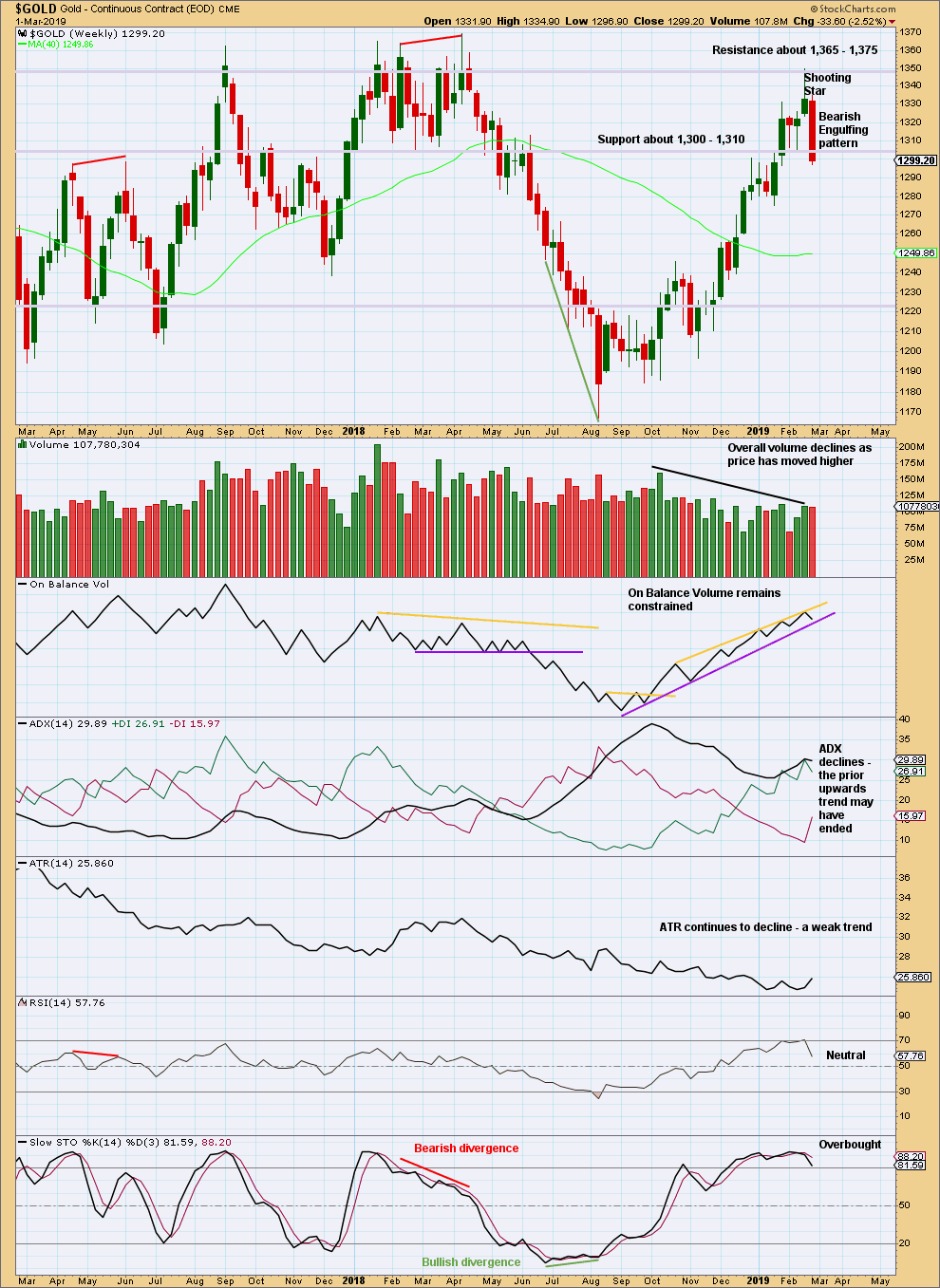
Click chart to enlarge. Chart courtesy of StockCharts.com.
There are now two bearish candlestick reversal patterns on the weekly chart: a Shooting Star and a Bearish Engulfing pattern. This supports the view that a high is in place.
DAILY CHART
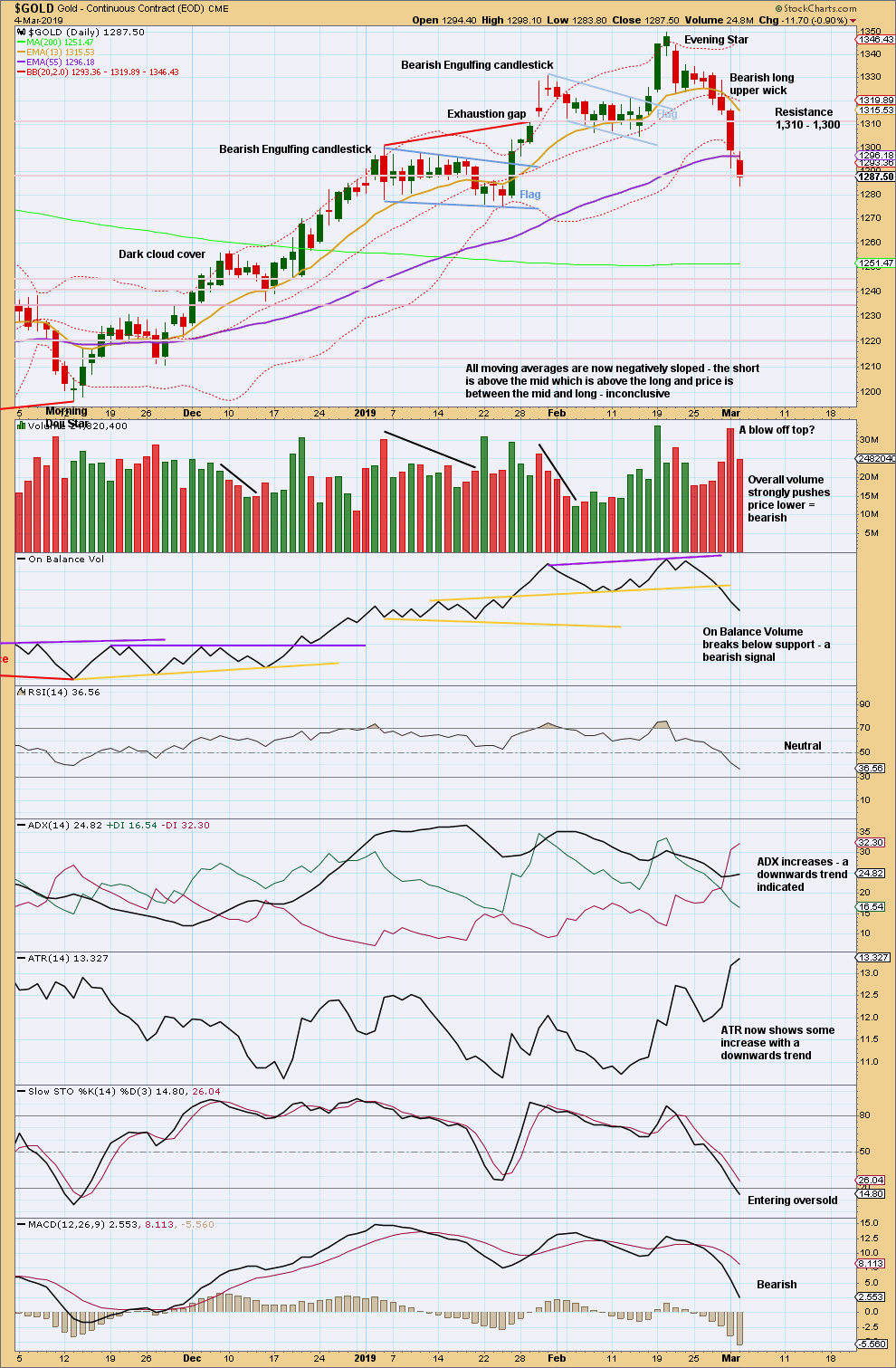
Click chart to enlarge. Chart courtesy of StockCharts.com.
The Evening Star reversal pattern indicates a trend change here to either down or sideways.
Price has now closed well below support at 1,300 .
Overall, this chart is bearish but not yet fully so.
GDX WEEKLY CHART

Click chart to enlarge. Chart courtesy of StockCharts.com.
The Bearish Engulfing pattern at the weekly chart level should be given weight in this analysis. It signals an end to the upwards trend and a new downwards or sideways trend.
GDX DAILY CHART
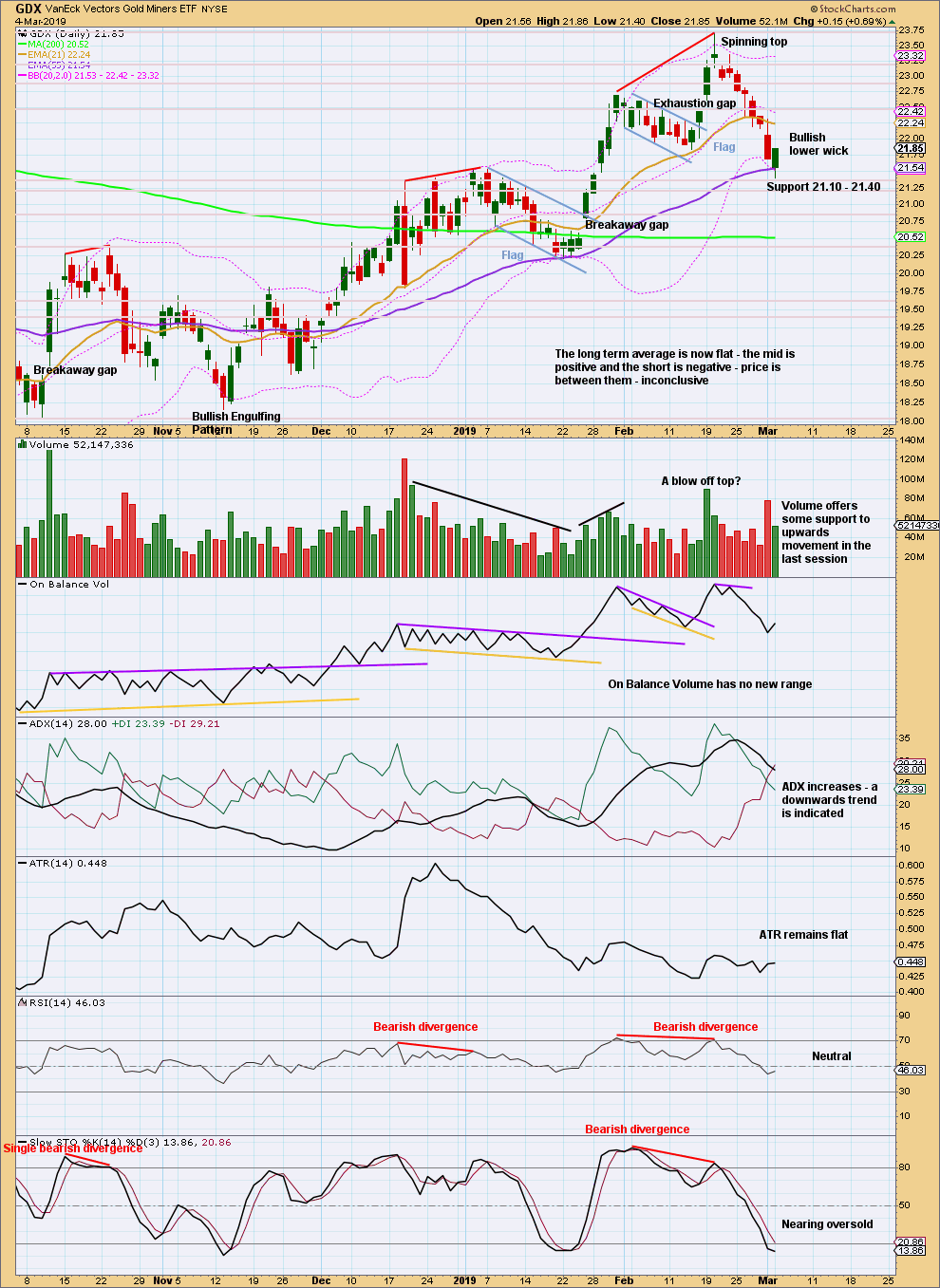
Click chart to enlarge. Chart courtesy of StockCharts.com.
A long lower wick and bounce off support suggests more upwards movement tomorrow for the short term. It looks like GDX may also have found a high; upwards movement here may be a counter trend bounce.
Look for next support about 21.40 to 21.10.
Published @ 06:20 p.m. EST.
—
Careful risk management protects your trading account(s).
Follow my two Golden Rules:
1. Always trade with stops.
2. Risk only 1-5% of equity on any one trade.

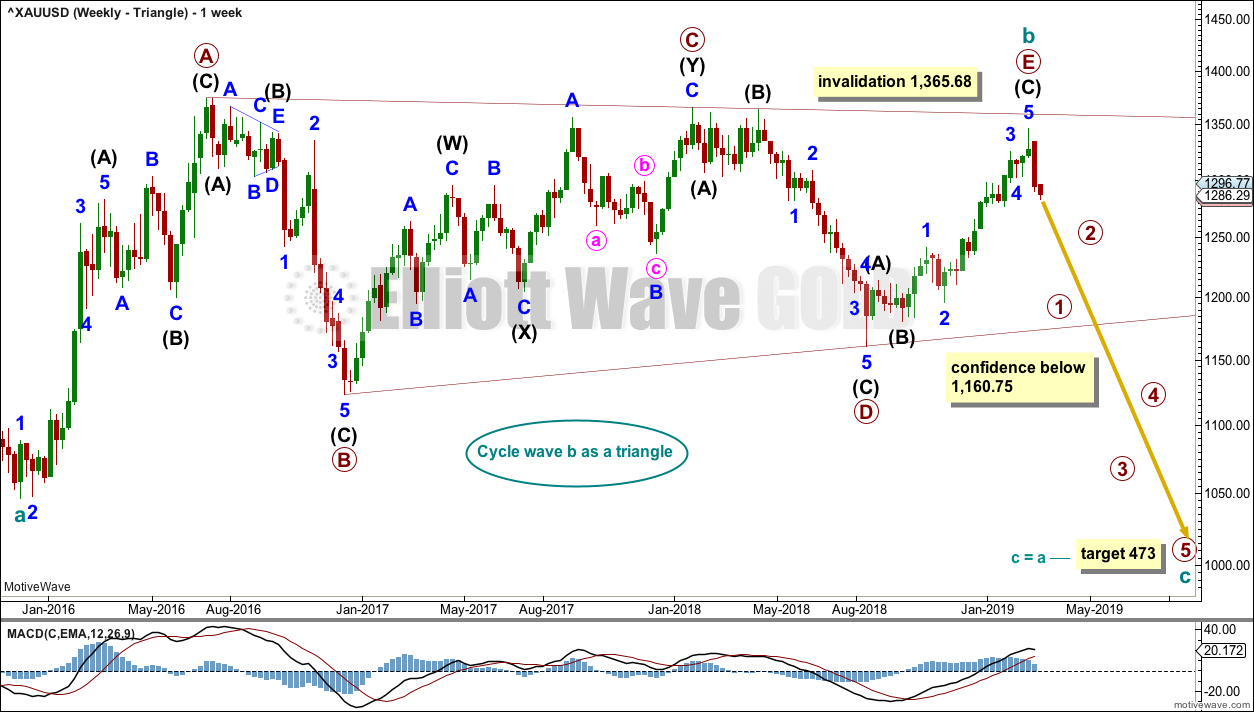
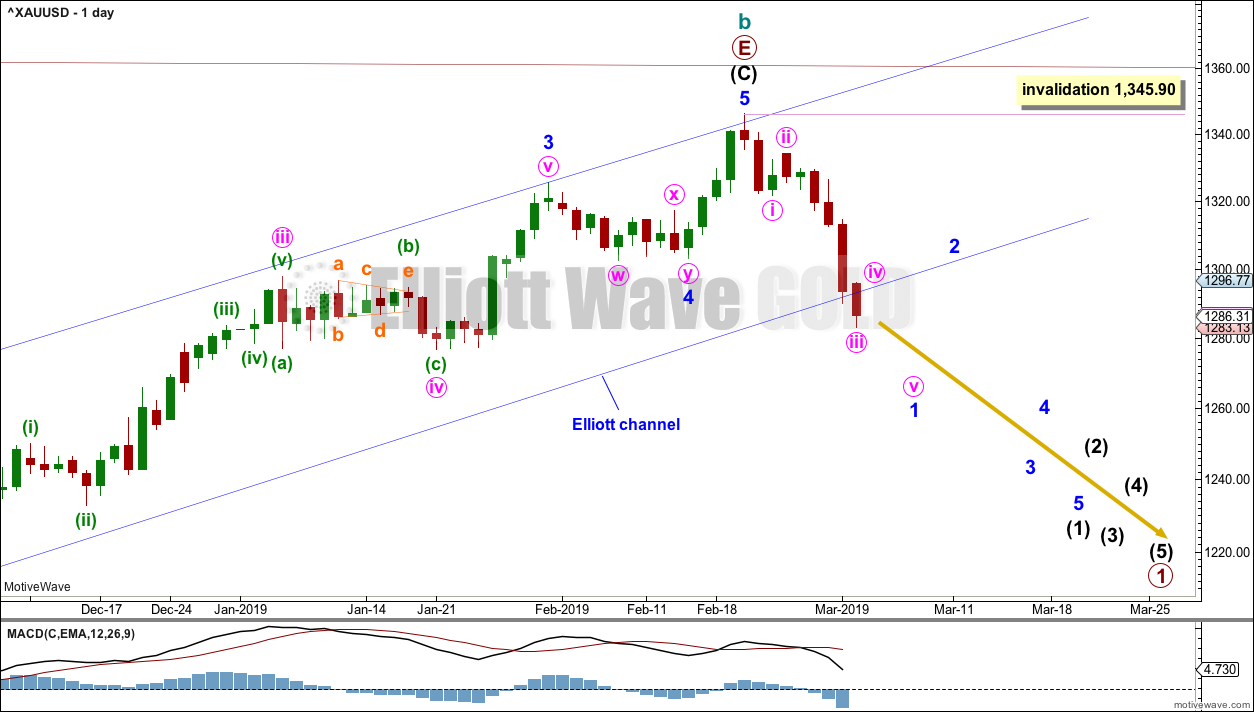


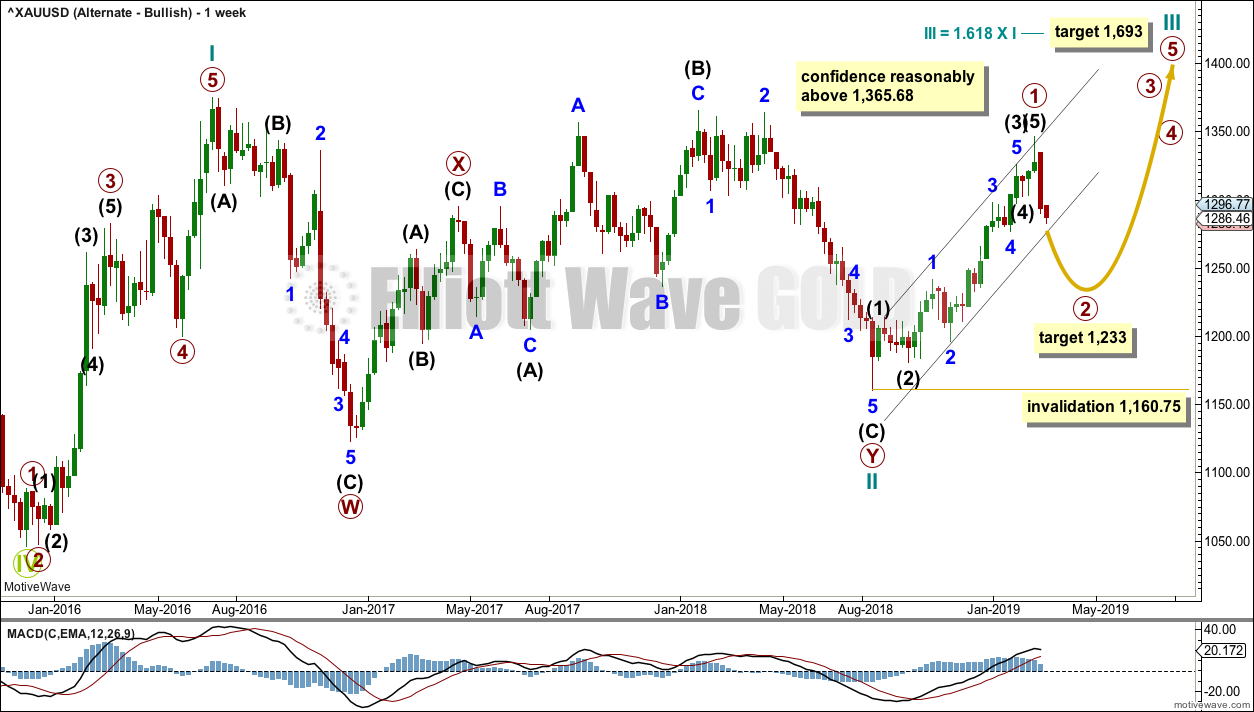
Updated daily chart:
I’m drawing a channel about minor wave 1 on the daily chart. When it’s breached by upwards movement, and for this instance I’ll take a close above the upper edge, that may indicate minor 1 as over and minor 2 as beginning.
Updated hourly chart:
Minute iv may now be over, minute v may now be underway. Price remains within the channel.
Because Gold tends to have curved impulses this channel may now be used to indicate when the impulse is over. The curve tends to be slowest at the start and end quickly. So when this channel is now breached by upwards movement that may indicate minor 1 as over and minor 2 as beginning. I’ll then use Fibonacci ratios of minor wave 1 for targets for minor wave 2.
Lara: A target is calculated for cycle wave c that expects to exhibit the most common Fibonacci ratio to cycle wave a.
Gold’s most common Fib may be 50%
So to avoid truncation could 50% at 906 may be a reasonable target for wave c?
FIBS vs C targets:
38%- 1011
50%- 906
68%- 748
100%- 473
The most common Fibonacci ratio between waves A and C within a zigzag is equality.
But it doesn’t have to be so, and yes, those other ratios are certainly possibilities.
I think when I update the historic analysis at the end of the week I’ll include more targets as you suggest. That may look less scary and extreme.
Lara, times (understand they are very generic) are always useful. From 1300 to 473 probably less alarming if seen with some time context.
I most appreciate your daily summary when it has both numeric targets and (generic) timelines.
True.
Time is harder to predict than price, but I’ll give it a go.